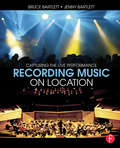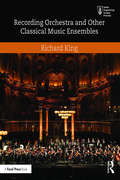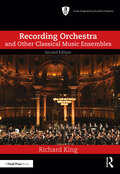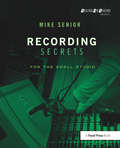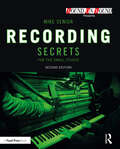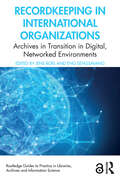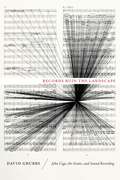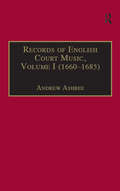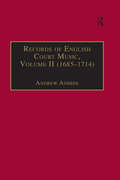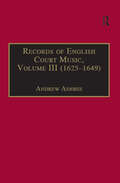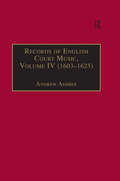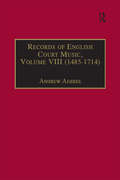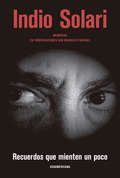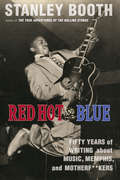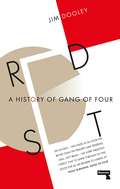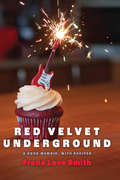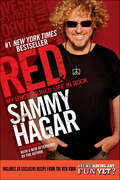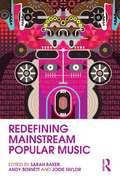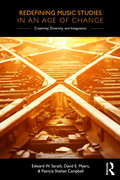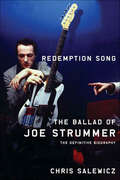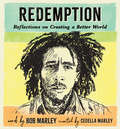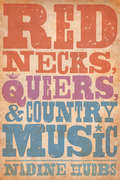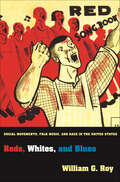- Table View
- List View
Recording Music on Location: Capturing the Live Performance
by Bruce BartlettRecording Music on Location provides an exceptional collection of information regarding all aspects of recording outside of the studio. Featuring clear explanations on how to achieve professional results, this book is divided into two distinct sections: popular music and classical music. Whether you record in the local rock club, jazz café, or in an orchestra hall, Bartlett offers sage advice on each stage of the process of location recording. Packed with hints and tips, this book is a great reference for anyone planning to venture outside of the studio. Audio examples, tracking sheets, weblinks, and downloadable checklists are available on the companion website at www.focalpress.com/cw/bartlett. This edition has been thoroughly updated and includes new sections on iOS devices, USB thumb-drive recorders, and digital consoles with built-in recorders, along with updated specs on recording equipment, software, and hardware. This edition will also show you how to prepare recordings for the web and live audio streaming, and covers spectral analysis, noise reduction, and parallel compression. A new case study will go in depth on classical-music recording.
Recording Orchestra and Other Classical Music Ensembles (Audio Engineering Society Presents)
by Richard KingRecording Orchestra and Other Classical Music Ensembles explores techniques and methodologies specific to recording classical music. Whether a newcomer or a seasoned engineer looking to refine their skills, this book speaks to all levels of expertise and covers every aspect of recording symphonic and concerto repertoire, opera, chamber music, and solo piano. With a focus on the orchestra as an instrument and sound source, this book features sections on how to listen, understanding microphones, concert halls, orchestra seating arrangements, how to set up the monitoring environment, and how to approach recording each section of the orchestra. Recording Orchestra provides concise information on preparing for a recording session, the role of the producer, mixing techniques, and includes a "quick-start" reference guide with suggested setups aimed at helping introduce the reader to the recording process. A companion website, featuring audio examples of various techniques, reinforces concepts discussed throughout the book. The content of the book includes: Clear, practical advice in plain language from an expert in classical music recording, multiple Grammy award winning recording engineer, and university professor The "secret of recording": a collection of practical recording techniques that have been proven to be highly successful in the field, on many occasions Never before published information written by an industry veteran with over twenty five-years of experience in classical music recording Specific techniques and strategies for recording orchestra, opera, wind symphony, chorus, string quartet, and other common classical music ensembles.
Recording Orchestra and Other Classical Music Ensembles (ISSN)
by Richard KingRecording Orchestra and Other Classical Music Ensembles explores techniques and methodologies specific to recording classical music. Whether the reader is a newcomer or a seasoned engineer looking to refine their skills, this book speaks to all levels of expertise and covers every aspect of recording symphonic and concerto repertoire, opera, chamber music and solo piano.With a focus on the orchestra as an instrument and sound source, Recording Orchestra and Other Classical Music Ensembles features sections on how to listen, understanding microphones, concert halls, orchestra seating arrangements, how to set up the monitoring environment and how to approach recording each section of the orchestra. Offering concise information on preparing for a recording session, the role of the producer and mixing techniques, whilst a "quick-start" reference guide with suggested setups also helps to introduce the reader to the recording process. Online Instructor and Student Resources, featuring audio and video examples of various techniques, further reinforces the concepts discussed throughout the book.This new edition has updated and expanded material, including new chapters on classical crossover projects, film score recording and immersive/3D recording and mixing, as well as a number of new case studies, making this an essential guide for students, researchers and professionals recording classical music.
Recording Secrets for the Small Studio (Sound On Sound Presents...)
by Mike SeniorDiscover how to achieve commercial-grade recordings, even in the smallest studios, by applying power-user techniques from the world's most successful producers. Recording Secrets for the Small Studio is an intensive training course specifically designed for small-studio enthusiasts who want a fast track to release-quality results. Based on the backroom strategies of more than 200 famous names, this thorough and down-to-earth guide leads you through a logical sequence of practical tasks to build your live-room skills progressively from the ground up. On the way, you'll unravel the mysteries of many specialist studio tactics and gain the confidence to tackle a full range of real-world recording situations. User-friendly explanations introduce technical concepts on a strictly need-to-know basis, while chapter summaries, assignments, and extensive online resources are perfect for school and college use. * Learn the fundamental principles of mic technique that you can apply in any recording scenario -- and how to avoid those rookie mistakes that all too often compromise the sonics of lower-budget productions. * Explore advanced techniques which help industry insiders maintain their competitive edge even under the most adverse conditions: creative phase manipulation, improvised acoustics tweaks, inventive monitoring workarounds, subtle psychological tricks... * Find out where you don't need to spend money, as well as how to make a limited budget really count. * Make the best use of limited equipment and session time, especially in situations where you're engineering and producing single-handed. * Pick up tricks and tips from celebrated engineers and producers across the stylistic spectrum, including Steve Albini, Roy Thomas Baker, Joe Barresi, Tchad Blake, Bruce Botnick, Joe Chiccarelli, Neil Dorfsman, Jack Douglas, Geoff Emerick, Paul Epworth, Humberto Gatica, Nigel Godrich, Andy Johns, Eddie Kramer, Kevin Killen, George Massenburg, Hugh Padgham, Alan Parsons, Jack Joseph Puig, Phil Ramone, Bob Rock, Elliott Scheiner, Al Schmitt, Bruce Swedien, Butch Vig, Tony Visconti, and many, many more...
Recording Secrets for the Small Studio (Sound On Sound Presents...)
by Mike SeniorIn this new edition, discover how to achieve commercial-grade recordings, even in the smallest studios, by applying power-user techniques from the world’s most successful producers. Recording Secrets for the Small Studio is based on the backroom strategies of more than 250 famous names. This thorough and down-to-earth guide leads you through a logical sequence of practical tasks to build your live-room skills progressively from the ground up, with user-friendly explanations that introduce technical concepts on a strictly need-to-know basis. On the way, you’ll unravel the mysteries of many specialist studio tactics and gain the confidence to tackle a full range of real-world recording situations. Specifically designed for small-studio enthusiasts, this book provides an intensive training course for those who want a fast track to releasing quality results, while the chapter summaries, assignments, and extensive online resources are perfect for school and college use. Learn the fundamental principles of mic technique that you can apply in any recording scenario – and how to avoid those rookie mistakes that all too often compromise the sonics of lower-budget productions. Explore advanced techniques which help industry insiders maintain their competitive edge even under the most adverse conditions: creative phase manipulation, improvised acoustics tweaks, inventive monitoring workarounds, and subtle psychological tricks. Find out where you don’t need to spend money, as well as how to make a limited budget really count. Make the best use of limited equipment and session time, especially in situations where you’re engineering and producing single-handed. Pick up tricks and tips from celebrated engineers and producers across the stylistic spectrum, including Steve Albini, Neal Avron, Roy Thomas Baker, Joe Barresi, Howard Benson, Tchad Blake, T-Bone Burnett, Geoff Emerick, Brian Eno, Paul Epworth, Shawn Everett, Humberto Gatica, Imogen Heap, Ross Hogarth, Trevor Horn, Rodney Jerkins, Leslie Ann Jones, Eddie Kramer, Jacquire King, Daniel Lanois, Sylvia Massy, Alan Meyerson, Justin Niebank, Gary Paczosa, Tony Platt, Jack Joseph Puig, David Reitzas, Bob Rock, Laura Sisk, Fraser T Smith, Young Guru, and many more. Now extensively expanded and updated, with new sections on contact mics, software instruments, squash mics, and ensemble depth distortion.
Recordkeeping in International Organizations: Archives in Transition in Digital, Networked Environments (Routledge Guides to Practice in Libraries, Archives and Information Science)
by Jens Boel Eng SengsavangRecordkeeping in International Organizations offers an important treatment of international organizations from a recordkeeping perspective, while also illustrating how recordkeeping can play a vital role in our efforts to improve global social conditions.Demonstrating that organizations have both a responsibility and an incentive to effectively manage their records in order to make informed decisions, remain accountable to stakeholders, and preserve institutional history, the book offers practical insights and critical reflections on the effective management, protection, and archiving of records. Through policy advice, surveys, mind mapping, case studies, and strategic reflections, the book provides guidance in the areas of archives, records, and information management for the future. Among the topics addressed are educational requirements for recordkeeping professionals, communication policies, data protection and privacy, cloud computing, classification and declassification policies, artificial intelligence, risk management, enterprise architecture, and the concepts of extraterritoriality and inviolability of archives. The book also offers perspectives on how digital recordkeeping can support the UN’s 2030 Agenda for Sustainable Development, and the accompanying Sustainable Development Goals (SDGs).Recordkeeping in International Organizations will be essential reading for records and archives professionals, information technology, legal, security, management, and leadership staff, including chief information officers. The book should also be of interest to students and scholars engaged in the study of records, archives, and information management, information technology, information security, and law.Chapters 7 and 9 of this book are freely available as a downloadable Open Access PDF at http://www.taylorfrancis.com under a Attribution-NonCommercial-ShareAlike (CC-BY-NC-SA) 4.0 license
Recordkeeping in International Organizations: Archives in Transition in Digital, Networked Environments (Routledge Guides to Practice in Libraries, Archives and Information Science)
by Jens Boel and Eng SengsavangRecordkeeping in International Organizations offers an important treatment of international organizations from a recordkeeping perspective, while also illustrating how recordkeeping can play a vital role in our efforts to improve global social conditions. Demonstrating that organizations have both a responsibility and an incentive to effectively manage their records in order to make informed decisions, remain accountable to stakeholders, and preserve institutional history, the book offers practical insights and critical reflections on the effective management, protection, and archiving of records. Through policy advice, surveys, mind mapping, case studies, and strategic reflections, the book provides guidance in the areas of archives, records, and information management for the future. Among the topics addressed are educational requirements for recordkeeping professionals, communication policies, data protection and privacy, cloud computing, classification and declassification policies, artificial intelligence, risk management, enterprise architecture, and the concepts of extraterritoriality and inviolability of archives. The book also offers perspectives on how digital recordkeeping can support the UN’s 2030 Agenda for Sustainable Development, and the accompanying Sustainable Development Goals (SDGs). Recordkeeping in International Organizations will be essential reading for records and archives professionals, information technology, legal, security, management, and leadership staff, including chief information officers. The book should also be of interest to students and scholars engaged in the study of records, archives, and information management, information technology, information security, and law.
Records Ruin the Landscape: John Cage, the Sixties, and Sound Recording
by David GrubbsJohn Cage's disdain for records was legendary. He repeatedly spoke of the ways in which recorded music was antithetical to his work. In Records Ruin the Landscape, David Grubbs argues that, following Cage, new genres in experimental and avant-garde music in the 1960s were particularly ill suited to be represented in the form of a recording. These activities include indeterminate music, long-duration minimalism, text scores, happenings, live electronic music, free jazz, and free improvisation. How could these proudly evanescent performance practices have been adequately represented on an LP?In their day, few of these works circulated in recorded form. By contrast, contemporary listeners can encounter this music not only through a flood of LP and CD releases of archival recordings but also in even greater volume through Internet file sharing and online resources. Present-day listeners are coming to know that era's experimental music through the recorded artifacts of composers and musicians who largely disavowed recordings. In Records Ruin the Landscape, Grubbs surveys a musical landscape marked by altered listening practices.
Records of English Court Music: Volume I (1660-1685)
by Andrew AshbeePioneering work on the musical material from the archives of the English court was undertaken by Nagel (1894), Lafontaine (1909) and Stokes (in the Musical Antiquary 1903-1913). Records of English Court Music (a series of seven volumes covering the period 1485-1714) is the first attempt to compile a systematic calendar of such references. It aims to revise these earlier studies where necessary, adding significant details which researchers omitted, clarifying the context of documents and substituting current call-marks for defunct references. Volume V is primarily concerned with the post-Restoration years already partially covered in volumes I and II. The material from the Exchequer and Declared Accounts of the Treasurer of the Chamber has been revised to include references to trumpeters and drummers. Other sections are devoted to material outside the Lord Chamberlain's papers: the Signet Office Docquet Books, Secret Service accounts and more from the Exchequer; the Corporation of Musick (controlled by the Court musicians) and to the range of music material from accounts of the Receivers General. Samples from the comprehensive records of the Lord Steward's department (including those of the Cofferer of the Household) are also provided. Andrew Ashbee was the winner of the Oldman Prize in 1987 for Volume II in the series of 'Records of English Court Music', awarded by the UK branch of the International Association of Music Libraries for the year's best book on music librarianship, bibliography and reference.
Records of English Court Music: Volume II (1685 -1714)
by Andrew AshbeePioneering work on the musical material from the archives of the English court was undertaken by Nagel (1894), Lafontaine (1909) and Stokes (in the Musical Antiquary 1903-1913). Records of English Court Music (a series of seven volumes covering the period 1485-1714) is the first attempt to compile a systematic calendar of such references. It aims to revise these earlier studies where necessary, adding significant details which researchers omitted, clarifying the context of documents and substituting current call-marks for defunct references. Volume V is primarily concerned with the post-Restoration years already partially covered in volumes I and II. The material from the Exchequer and Declared Accounts of the Treasurer of the Chamber has been revised to include references to trumpeters and drummers. Other sections are devoted to material outside the Lord Chamberlain's papers: the Signet Office Docquet Books, Secret Service accounts and more from the Exchequer; the Corporation of Musick (controlled by the Court musicians) and to the range of music material from accounts of the Receivers General. Samples from the comprehensive records of the Lord Steward's department (including those of the Cofferer of the Household) are also provided. Andrew Ashbee was the winner of the Oldman Prize in 1987 for Volume II in the series of 'Records of English Court Music', awarded by the UK branch of the International Association of Music Libraries for the year's best book on music librarianship, bibliography and reference.
Records of English Court Music: Volume III (1625-1649)
by Andrew AshbeePioneering work on the musical material from the archives of the English court was undertaken by Nagel (1894), Lafontaine (1909) and Stokes (in the Musical Antiquary 1903-1913). Records of English Court Music (a series of seven volumes covering the period 1485-1714) is the first attempt to compile a systematic calendar of such references. It aims to revise these earlier studies where necessary, adding significant details which researchers omitted, clarifying the context of documents and substituting current call-marks for defunct references. Volume V is primarily concerned with the post-Restoration years already partially covered in volumes I and II. The material from the Exchequer and Declared Accounts of the Treasurer of the Chamber has been revised to include references to trumpeters and drummers. Other sections are devoted to material outside the Lord Chamberlain's papers: the Signet Office Docquet Books, Secret Service accounts and more from the Exchequer; the Corporation of Musick (controlled by the Court musicians) and to the range of music material from accounts of the Receivers General. Samples from the comprehensive records of the Lord Steward's department (including those of the Cofferer of the Household) are also provided. Andrew Ashbee was the winner of the Oldman Prize in 1987 for Volume II in the series of 'Records of English Court Music', awarded by the UK branch of the International Association of Music Libraries for the year's best book on music librarianship, bibliography and reference.
Records of English Court Music: Volume IV (1603–1625)
by Andrew AshbeePioneering work on the musical material from the archives of the English court was undertaken by Nagel (1894), Lafontaine (1909) and Stokes (in the Musical Antiquary 1903-1913). Records of English Court Music (a series of seven volumes covering the period 1485-1714) is the first attempt to compile a systematic calendar of such references. It aims to revise these earlier studies where necessary, adding significant details which researchers omitted, clarifying the context of documents and substituting current call-marks for defunct references. Volume V is primarily concerned with the post-Restoration years already partially covered in volumes I and II. The material from the Exchequer and Declared Accounts of the Treasurer of the Chamber has been revised to include references to trumpeters and drummers. Other sections are devoted to material outside the Lord Chamberlain's papers: the Signet Office Docquet Books, Secret Service accounts and more from the Exchequer; the Corporation of Musick (controlled by the Court musicians) and to the range of music material from accounts of the Receivers General. Samples from the comprehensive records of the Lord Steward's department (including those of the Cofferer of the Household) are also provided. Andrew Ashbee was the winner of the Oldman Prize in 1987 for Volume II in the series of 'Records of English Court Music', awarded by the UK branch of the International Association of Music Libraries for the year's best book on music librarianship, bibliography and reference.
Records of English Court Music: Volume VIII : 1485-1714
by Andrew AshbeePioneering work on the musical material from the archives of the English court was undertaken by Nagel (1894), Lafontaine (1909) and Stokes (in the Musical Antiquary 1903-1913). Records of English Court Music (a series of seven volumes covering the period 1485-1714) is the first attempt to compile a systematic calendar of such references. It aims to revise these earlier studies where necessary, adding significant details which researchers omitted, clarifying the context of documents and substituting current call-marks for defunct references. Volume V is primarily concerned with the post-Restoration years already partially covered in volumes I and II. The material from the Exchequer and Declared Accounts of the Treasurer of the Chamber has been revised to include references to trumpeters and drummers. Other sections are devoted to material outside the Lord Chamberlain's papers: the Signet Office Docquet Books, Secret Service accounts and more from the Exchequer; the Corporation of Musick (controlled by the Court musicians) and to the range of music material from accounts of the Receivers General. Samples from the comprehensive records of the Lord Steward's department (including those of the Cofferer of the Household) are also provided. Andrew Ashbee was the winner of the Oldman Prize in 1987 for Volume II in the series of 'Records of English Court Music', awarded by the UK branch of the International Association of Music Libraries for the year's best book on music librarianship, bibliography and reference.
Recuerdos que mienten un poco: Memorias. En conversaciones con Marcelo Figueras
by Indio SolariLas memorias del Indio Solari, creador y líder de Patricio Rey y sus Redonditos de Ricota, desde sus orígenes en Paraná hace 70 años hasta hoy, atravesando la historia de sus bandas disco por disco, sus comienzos, sus influencias, su independencia militante, su compleja relación con los medios, sus polémicas, y su presente personal y artístico. La primera autobiografía completa y en primera persona de Carlos Alberto "El Indio" Solari (Paraná, 1949), fundador junto con Skay Beilinson de Patricio Rey y sus Redonditos de Ricota. Mediante el recorrido de su vida y una obra (sus influencias y sus temas) que lo convirtió en icono de la escena contracultural del rock argentino, nos acercamos al contenido de sus letras y sus melodías, sus ídolos, la relación con su público y con la prensa (su renuencia a aparecer en medios masivos), con sus compañeros de bandas y también con los músicos de su generación. Atravesando su trayectoria junto a los Redondos hasta la disolución en 2001; la historia de los cuatro discos que grabó con su nuevo grupo, Los Fundamentalistas del Aire Acondicionado, y su presente -ahora que ha aceptado hablar públicamente sobre su enfermedad-, el Indio, el artista militante del NO-TELEVISIÓN, lo cuenta todo.
Red Hot and Blue: Fifty Years of Writing About Music, Memphis, and Motherf**kers
by Stanley BoothThis collection of over fifty years of writing about the South and its music by Stanley Booth, one of the undisputedly great chroniclers of the subject, is a classic, essential read. Booth's close contacts with many of the musicians he writes about provide a gateway to truly understanding the music and culture of Memphis and other blues strongholds in the South. Subjects include Elvis Presley, Otis Redding, William Eggleston, Ma Rainey, Blind Willie McTell, Graceland, Beale Street and much more.
Red Set: A History Gang of Four
by James DooleyBased on detailed interviews with band members, Red Set considers the music, art and politics that shaped Gang of Four and how the band, in turn, left an indelible mark on popular music.In the autumn of 1976, two young British Fine Arts students travelled to New York on a university grant, but instead of merely studying ended up staying with one of the city’s pioneering punk journalists, visiting the Museum of Modern Art by day and hanging out in punk epicentre CBGBs by night. It is from this trip that Gang of Four emerged. Blending revelations from interviews with the band conducted by the author with snippets from newspaper articles and record reviews, Jim Dooley tells the history of Gang of Four as they remember it. From their days at art school through countless tours, records and reunions, Red Set is the definitive history of one of Britain’s greatest and most influential bands.
Red Velvet Underground: A Rock Memoir, with Recipes
by Freda Love Smith“Not only a rock memoir and recipe book but also a poignant work of personal self-discovery and the challenges yet joys of parenting.” —Huffington PostPart memoir, part cookbook, and all rock and roll, Red Velvet Underground tells the story of how musician Freda Love Smith’s indie-rock past grew into her family—and food-centric present.Smith, born in Nashville and raised in Indiana, is best known as the drummer and co-founder of bands such as the Boston-based Blake Babies, Antenna, and the Mysteries of Life. Red Velvet Underground is loosely framed around cooking lessons Smith gave to her eldest son, Jonah, before he left for college. Smith compares her son’s experiences to her own—meeting Juliana Hatfield and starting the Blake Babies, touring in Evan Dando’s hand-me-down station wagon, and crashing with Henry Rollins, who introduced the band to local California fare—all while plumbing the deeper meanings behind the role of food, cooking, and family.Interspersed throughout these stories are forty-five flexitarian recipes—mostly, but not exclusively, vegetarian—such as red pepper-cashew spread, spinach and brazil nut pesto, and vegan strawberry-cream scones. Throughout the book, Smith reveals how food, in addition to music, has evolved into an important means for creativity and improvisation. Red Velvet Underground is an engaging exploration of the ways food and music have informed identity through every stage of one woman’s life.“These are sweet, unsentimental scenes from the ever-evolving life of a woman of many shifting and balancing roles: mother, wife, drummer, student, teacher, friend, daughter, food enthusiast. It’s all tied together with tantalizing recipes that have been lovingly improvised and tweaked into a life-affirming doneness.” —Juliana Hatfield, musician
Red: My Uncensored Life in Rock
by Sammy Hagar Joel SelvinThe former Van Halen front man recounts his life, from his childhood to his wild days in rock ‘n’ roll, in this one-of-a-kind memoir.For almost forty years, Sammy Hagar has been a fixture in rock music. From breaking into the industry with the band Montrose to his multiplatinum solo career to his ride as the front man of Van Halen, Sammy’s powerful and unforgettable voice has set the tone for some of the greatest rock anthems ever written—songs like “I Can’t Drive 55,” “Right Now,” and “Why Can’t This Be Love.”In Red, Sammy tells the outrageous story of his tear through rock ‘n’ roll. From the decadence of being one of the world’s biggest rock stars to the unfiltered story of being forced out of Van Halen, Sammy’s account spares no one, least of all himself. His is a tale of a true rock ‘n’ roller—someone who’s spent decades bringing the party with wherever he goes but always headin’ back to Cabo for más tequila.Praise for Red“There are tell-all books, and then there are tell-all books written by Sammy Hagar. The ex-Van Halen front man holds back nothing—and I mean absolutely nothing. . . . Red is jam-packed with great anecdotes . . . and other tidbits that take fans of music and pop culture to places they normally wouldn’t get to go.” —Associated Press
Redefining Mainstream Popular Music
by Andy Bennett Sarah Baker Jodie TaylorRedefining Mainstream Popular Music is a collection of seventeen essays that critically examines the idea of the "mainstream" in and across a variety of popular music styles and contexts. Notions of what is popular vary across generations and cultures – what may have been considered alternative to one group may be perceived as mainstream to another. Incorporating a wide range of popular music texts, genres, scenes, practices and technologies from the United Kingdom, North America, Australia and New Zealand, the authors theoretically challenge and augment our understanding of how the mainstream is understood and functions in the overlapping worlds of popular music production, consumption and scholarship. Spanning the local and the global, the historic and contemporary, the iconic and the everyday, the book covers a broad range of genres, from punk to grunge to hip-hop, while also considering popular music through other mediums, including mash-ups and the music of everyday work life. Redefining Mainstream Popular Music provides readers with an innovative and nuanced perspective of what it means to be mainstream.
Redefining Music Studies in an Age of Change: Creativity, Diversity, and Integration
by Patricia Shehan Campbell Edward W. Sarath David E. MyersRedefining Music Studies in an Age of Change: Creativity, Diversity, Integration takes prevailing discourse about change in music studies to new vistas, as higher education institutions are at a critical moment of determining just what professional musicians and teachers need to survive and thrive in public life. The authors examine how music studies might be redefined through the lenses of creativity, diversity, and integration. which are the three pillars of the recent report of The College Music Society taskforce calling for reform. Focus is on new conceptions for existent areas—such as studio lessons and ensembles, academic history and theory, theory and culture courses, and music education coursework—but also on an exploration of music and human learning, and an understanding of how organizational change happens. Examination of progressive programs will celebrate strides in the direction of the task force vision, as well as extend a critical eye distinguishing between premature proclamations of “mission accomplished” and genuine transformation. The overarching theme is that a foundational, systemic overhaul has the capacity to entirely revitalize the European classical tradition. Practical steps applicable to wide-ranging institutions are considered—from small liberal arts colleges, to conservatory programs, large research universities, and regional state universities.
Redemption Hymns
by Lindsay G SmithThis is a nondenominational words-only collection of 703 hymns and songs published in New Zealand in 2009. It includes such hymns as Standing on the Promises, His Eye Is on the Sparrow and many other popular hymns with rousing refrains affirming the Christian faith. You'll find 25 hymns by the blind hymn writer Fanny J. Crosby including Blessed Assurance. There's a topical index and an index of first lines and refrains. As with other hymnbooks on Bookshare, this too has DAISY markup for each hymn at level 1. In a BRF file, Bookshare software will create a lengthy table of contents followed by the text of the hymn book. For other hymn collections on Bookshare see also Christian Hymns; The New Believers Hymn Book; Gospel Hymn Book; The United Methodist Hymnal; Glory to God (Presbyterian); Evangelical Lutheran Worship (ELCA); and Lutheran Servicebook: Psalms and Hymns (Missouri Synod). For texts of cantatas by Johann Sebastian Bach, see The Church Cantatas of J. S. Bach by Alec Robinson (with commentary), and Johann Sebastian Bach: The Complete Cantatas in German-English translations by Richard Stokes.
Redemption Song: The Ballad of Joe Strummer
by Chris SalewiczWith exclusive access to Strummer's friends, relatives, and fellow musicians, music journalist Chris Salewicz penetrates the soul of an rock 'n roll icon. The Clash was--and still is--one of the most important groups of the late 1970s and early 1980s. Indebted to rockabilly, reggae, Memphis soul, cowboy justice, and '60s protest, the overtly political band railed against war, racism, and a dead-end economy, and in the process imparted a conscience to punk. Their eponymous first record and London Calling still rank in Rolling Stone's top-ten best albums of all time, and in 2003 they were officially inducted into the Rock and Roll Hall of Fame. Joe Strummer was the Clash's front man, a rock-and-roll hero seen by many as the personification of outlaw integrity and street cool. The political heart of the Clash, Strummer synthesized gritty toughness and poetic sensitivity in a manner that still resonates with listeners, and his untimely death in December 2002 shook the world, further solidifying his iconic status. Salewicz was a friend to Strummer for close to three decades and has covered the Clash's career and the entire punk movement from its inception. He uses his vantage point to write Redemption Song, the definitive biography of Strummer, charting his enormous worldwide success, his bleak years in the wilderness after the Clash's bitter breakup, and his triumphant return to stardom at the end of his life. Salewicz argues for Strummer's place in a long line of protest singers that includes Woody Guthrie, John Lennon, and Bob Marley, and examines by turns Strummer's and punk's ongoing cultural influence.
Redemption: Reflections on Creating a Better World
by Bob Marley Cedella MarleyFilled with quotes from Bob Marley&’s speeches, interviews, and writings, this illustrated collection is sure to resonate with fans of his music and political activism, at a time when we need exemplary heroes. Redemption has many meanings, but there is one definition that embodies the spirit of Bob Marley&’s beliefs and music: to reform, or to change for the better. Forty years after the release of his iconic &“Redemption Song,&” his desire to make the world a better place through mental and spiritual emancipation—important first steps to physical emancipation for the larger community—remains powerful and vital to this day.Using Marley&’s own words from interviews and his powerful song lyrics, his eldest daughter, Cedella Marley, creates a powerful narrative about the hard but rewarding path to redemption.
Rednecks, Queers, and Country Music
by Nadine HubbsIn her provocative new book Rednecks, Queers, and Country Music, Nadine Hubbs looks at how class and gender identity play out in one of America's most culturally and politically charged forms of popular music. Skillfully weaving historical inquiry with an examination of classed cultural repertoires and close listening to country songs, Hubbs confronts the shifting and deeply entangled workings of taste, sexuality, and class politics. In Hubbs's view, the popular phrase "I'll listen to anything but country" allows middle-class Americans to declare inclusive "omnivore" musical tastes with one crucial exclusion: country, a music linked to low-status whites. Throughout Rednecks, Queers, and Country Music, Hubbs dissects this gesture, examining how provincial white working people have emerged since the 1970s as the face of American bigotry, particularly homophobia, with country music their audible emblem. Bringing together the redneck and the queer, Hubbs challenges the conventional wisdom and historical amnesia that frame white working folk as a perpetual bigot class. With a powerful combination of music criticism, cultural critique, and sociological analysis of contemporary class formation, Nadine Hubbs zeroes in on flawed assumptions about how country music models and mirrors white working-class identities. She particularly shows how dismissive, politically loaded middle-class discourses devalue country's manifestations of working-class culture, politics, and values, and render working-class acceptance of queerness invisible. Lucid, important, and thought-provoking, this book is essential reading for students and scholars of American music, gender and sexuality, class, and pop culture.
Reds, Whites, and Blues: Social Movements, Folk Music, and Race in the United States (Princeton Studies in Cultural Sociology #45)
by William G. RoyMusic, and folk music in particular, is often embraced as a form of political expression, a vehicle for bridging or reinforcing social boundaries, and a valuable tool for movements reconfiguring the social landscape. Reds, Whites, and Blues examines the political force of folk music, not through the meaning of its lyrics, but through the concrete social activities that make up movements. Drawing from rich archival material, William Roy shows that the People's Songs movement of the 1930s and 40s, and the Civil Rights Movement of the 1950s and 60s implemented folk music's social relationships--specifically between those who sang and those who listened--in different ways, achieving different outcomes. Roy explores how the People's Songsters envisioned uniting people in song, but made little headway beyond leftist activists. In contrast, the Civil Rights Movement successfully integrated music into collective action, and used music on the picket lines, at sit-ins, on freedom rides, and in jails. Roy considers how the movement's Freedom Songs never gained commercial success, yet contributed to the wider achievements of the Civil Rights struggle. Roy also traces the history of folk music, revealing the complex debates surrounding who or what qualified as "folk" and how the music's status as racially inclusive was not always a given. Examining folk music's galvanizing and unifying power, Reds, Whites, and Blues casts new light on the relationship between cultural forms and social activity.
